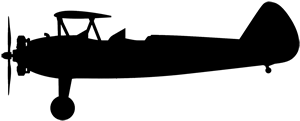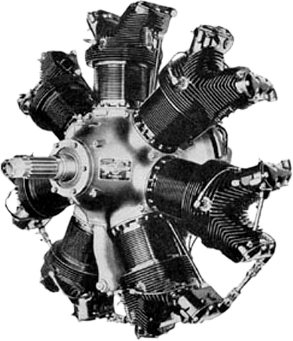|
The Stearman (Boeing) Model 75 is a biplane that was used
as a military trainer aircraft, of which at least 10,584
were built in the United States during the 1930s and 1940s.
Stearman Aircraft, of Wichita, Kansas, became a subsidiary
of the Boeing Aircraft Company in 1934, and introduced the
Model 75 Kaydet that year. Widely known as the Stearman,
Boeing Stearman, or Kaydet, it served as a primary trainer
for the USAAF, the USN and Marine Corps, and the RCAF
throughout World War II.
It was a conventional biplane and became an unexpected
success during World War II. Despite its almost obsolete
design, its simple, rugged construction made it ideal as a
trainer for novice pilots in the U.S. Army Air Force, and
the U.S. Navy and Marine Corps. The Model 75 had a large
fixed tail wheel undercarriage, and accommodation for the
student and instructor in tandem open cockpits. The biplane
had fabric-covered wooden wings, single-leg landing gear and
an over-built welded-steel fuselage. Only radial engines
were used and were typically uncowled, although some
Stearman operators choose to cowl the engine. Between 1936
and 1944, Boeing built 8,584 Kaydets, in all versions, plus
the equivalent of 2,000 more in spares.
The name "Yellow Peril" was not the official name of this
aircraft but a colloquialism applied to several primary
trainers, especially the Boeing/Stearman NS and N2S Kaydets.
The name originated from the fact that all naval trainers
had been painted orange-yellow since 1917 as well as from
its use in Naval Aviation Reserve Bases where soon-to-be
Aviation Cadets received their first training. In the event
that a cadet failed to solo within a certain period of time,
he was in "Peril" of washing out as an Aviation Cadet and
not becoming a Naval Aviator.
Ed Scharch was stationed at NAS Minneapolis and billeted
at Wold-Chamberlain Field from July 28, 1943 to October
24, 1943. As an Aviation Cadet, he successfully
completed primary flight training in a Yellow Peril.
During that time, Lt. Comdr. D.M. Campbell, USNR, was
the Commanding Officer of NAS Minneapolis, and Lt.
Comdr. W. M. Hanson, USNR, was the Executive Officer.
Campbell replaced Lt. Comdr. H. C. Doan, USN, as the new
C.O. on 25 June 1942.
The Stearman Kaydets were widely used airplanes.
Following the war, thousands of surplus aircraft were sold
on the civilian market. Their slow, low-level flying
capabilities made them particularly suitable for crop
dusting and spraying. They also became popular as sports
planes, and for aerobatic and wing walking use in airshows.
Many were still in service in the early 1990s.
|
|
Specifications
Boeing-Stearman N2S Kaydet
Wichita 75 model (Stearman Aircraft Division/Boeing)
| General
Characteristics |
| Crew: |
|
Two-seat tandem trainer |
| Length:
|
|
24 ft 3 in (7.39 m) |
| Wingspan:
|
|
32 ft 2 in (9.81 m) |
| Height:
|
|
9 ft 2 in (2.79 m) |
| Wing area:
|
|
298 sq ft (27.7 m²) |
| Empty weight:
|
|
1,936 lb (878 kg) |
| Gross
weight: |
|
2,717 lb (1,232 kg) |
|
Max takeoff weight: |
|
2,717 lb (1,232 kg) |
| Powerplant: |
|
1× Continental R-670-5, 220 hp (164 kW) |
| |
|
|
| Performance |
|
Maximum speed: |
|
124 mph (199.6 km/h) |
| Cruise
speed: |
|
106 mph (170.6 km/h) |
| Range: |
|
505 mi (812.7 km) |
| Rate of climb:
|
|
578 ft/min (2.93 m/s) |
| Service ceiling: |
|
11,200 ft (3,413.7 m) |
| Power
/ mass |
|
220 hp Continental R-670-5 piston, radial
engine |
|
|
|
 |
|
Aircraft silhouette |
|
|
|
|
|
|
 |
Stearman Aircraft Company
Division of
Boeing Airplane Company |
|
|
|
Engine Specifications
Continental R-670-K
|
General Specs |
|
|
| Type: |
|
Seven-cylinder air-cooled radial piston |
| Bore: |
|
5.125 in (130.2 mm) |
| Stroke:
|
|
4.625 in (117.5 mm) |
| Displacement:
|
|
668 cu in (10.95 liter) |
| Length:
|
|
34.188 in (868.4 mm) |
|
Diameter: |
|
42.50 in (1,079 mm) |
| Dry weight:
|
|
450 lbs (204 kg) |
|
|
|
|
|
Components |
|
|
| Valvetrain:
|
|
Two OHD valves per cylinder |
| Fuel system:
|
|
1 Stromberg
NA-R6 carburetor |
| Fuel type:
|
|
65 octane |
| Oil system:
|
|
Dry sump, one pressure and one scavenge
pump, enclosed valve-train |
| Cooling system:
|
|
Air-cooled |
|
|
|
|
|
Performance |
|
|
| Power output:
|
|
225 hp @ 2,175 rpm |
| Specific power:
|
|
0.337 hp/in³ |
| Compression ratio: |
|
5.4:1 |
| Fuel consumption:
|
|
13 US Gal/hr at cruising rpm |
| Oil consumption:
|
|
0.4 US Gal/hr at cruising rpm |
| Power-to-weight ratio: |
|
0.49 hp/lb at cruising rpm |
|
| |
| Continental |
| R-670-K, 7-cylinder radial
|
 |
| The engine's displacement was 668 cubic
inches. A single-row, 7-cylinder radial
design delivering 225 hp at 2,175 rpm with
5.4:1 compression ratio. Over 40,000
of these engines were built before and
during WWII. |
| |
 |
Continental
Aircraft Engine Company
Detroit,
Michigan |
|
|